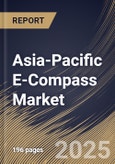The China market dominated the Asia-Pacific E-Compass Market by country in 2024, and is expected to continue to be a dominant market till 2032; thereby, achieving a market value of $463.3 million by 2032. The Japan market is registering a CAGR of 9.9% during 2025-2032. Additionally, the India market is expected to showcase a CAGR of 11.5% during 2025-2032. The China and Japan led the Asia-Pacific E-Compass Market by Country with a market share of 36.4% and 18.4% in 2024. The Malaysia market is expected to witness a CAGR of 14.1% during throughout the forecast period.
The Asia-Pacific region has become a key center for the development and use of e-compass technology. This is because of strong electronics manufacturing, growing consumer demand, and government support for smart city projects and advanced digital infrastructure. MEMS advancements in countries like China, Japan, South Korea, Taiwan, and Singapore have made it possible for standalone magnetometers to become integrated 9-axis orientation modules that combine accelerometers, gyroscopes, and magnetometers. These modules, which are often used with advanced sensor fusion software, produce outputs that are ready to use and can resist distortion, self-calibrate, and work well in real-world situations. They can be used in smartphones, wearables, drones, IoT devices, and robotics, especially in cities and factories where GPS or visual cues may not work well.
Market trends point to adaptive sensor fusion, ultra-low power consumption, and vertical specialization. These trends make it possible to reliably orient devices even when there is magnetic interference, extend the operational life of devices with limited battery life, and create domain-optimized modules for automotive, industrial, and surveying applications. Top companies are working on strategies that include integrating hardware and software, working with OEMs to develop new products, making products in the same country, and providing lifecycle services like remote calibration and firmware updates. This creates a managed, high-performance sensor ecosystem. Competition is organized but fierce, with module vendors and manufacturers standing out based on noise performance, drift stability, integration support, and ecosystem alignment. Scale, IP control, and regional presence are all important strategic advantages for meeting the Asia-Pacific's high-volume, performance-driven demand.
Technology Outlook
Based on Technology, the market is segmented into Hall-Effect, AMR / GMR / TMR, Fluxgate, Magneto-Inductive, and Quantum (NV-center, Optically-pumped). The Hall-Effect market segment dominated the China E-Compass Market by Technology is expected to grow at a CAGR of 7.8 % during the forecast period thereby continuing its dominance until 2032. Also, The Quantum (NV-center, Optically-pumped) market is anticipated to grow as a CAGR of 13.2 % during the forecast period during 2025-2032.Application Outlook
Based on Application, the market is segmented into Consumer Electronics, Automotive (Navigation, ADAS), Aerospace & Defense, Industrial & Robotics, Marine & Sub-sea, Healthcare & Wearables, and Others. Among various Singapore E-Compass Market by Application; The Consumer Electronics market achieved a market size of USD $11.6 Million in 2024 and is expected to grow at a CAGR of 11.2 % during the forecast period. The Marine & Sub-sea market is predicted to experience a CAGR of 14.8% throughout the forecast period from (2025 - 2032).Country Outlook
China's E Compass market is closely tied to its huge consumer electronics and smartphone manufacturing industry, which uses standard orientation sensors in smartphones, wearables, IoT devices, and smart systems. Strong domestic demand, large-scale production, and vertically integrated manufacturing clusters in places like Shenzhen and the Pearl River Delta make sensors cheaper and easier to use. Growth is also fueled by the BeiDou navigation system, government policies that support semiconductor self-sufficiency, and a strong local smartphone market. Some trends are making things smaller, using low-power multi-axis fusion, and adding them to IMUs for AR/VR, drones, and self-driving cars. Real-time calibration helps with magnetic interference in cities. Competition brings together global sensor companies and local MEMS companies that can customize, calibrate, and get close to the supply chain. Recent strategies include vertical integration, calibration labs in the same country, working with OEMs, and research and development in sensitivity, temperature compensation, and rejecting magnetic interference.List of Key Companies Profiled
- STMicroelectronics N.V.
- Asahi Kasei Corporation
- Robert Bosch GmbH
- Honeywell International, Inc.
- NXP Semiconductors N.V.
- TDK Corporation
- Infineon Technologies AG
- MEMSIC Semiconductor Co., Ltd. (IDG Capital Investment Consultant Beijing Co Ltd.)
- Allegro Microsystems, Inc. (Sanken Electric Co., Ltd.)
- Garmin Ltd.
Market Report Segmentation
By Axis Orientation
- 3-Axis
- 6- & 9-Axis Sensor Fusion
- 1-2-Axis
By Technology
- Hall-Effect
- AMR / GMR / TMR
- Fluxgate
- Magneto-Inductive
- Quantum (NV-center, Optically-pumped)
By Form Factor
- Integrated Sensor-Combo (Accel + Mag)
- SoC-embedded e-Compass
- Discrete Compass Modules
- Dev-Boards & Custom ASICs
By Application
- Consumer Electronics
- Automotive (Navigation, ADAS)
- Aerospace & Defense
- Industrial & Robotics
- Marine & Sub-sea
- Healthcare & Wearables
- Others
By Country
- China
- Japan
- India
- South Korea
- Singapore
- Malaysia
- Rest of Asia-Pacific
Table of Contents
Companies Mentioned
- STMicroelectronics N.V.
- Asahi Kasei Corporation
- Robert Bosch GmbH
- Honeywell International, Inc.
- NXP Semiconductors N.V.
- TDK Corporation
- Infineon Technologies AG
- MEMSIC Semiconductor Co., Ltd. (IDG Capital Investment Consultant Beijing Co Ltd.)
- Allegro Microsystems, Inc. (Sanken Electric Co., Ltd.)
- Garmin Ltd.








